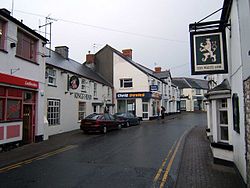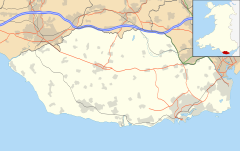Llantwit Major
Llantwit Major
|
|
|---|---|
 East Street, Llantwit Major |
|
| Llantwit Major shown within the Vale of Glamorgan | |
| Population | 9,486 (2011) |
| OS grid reference | SS975685 |
| Principal area | |
| Ceremonial county | |
| Country | Wales |
| Sovereign state | United Kingdom |
| Post town | LLANTWIT MAJOR |
| Postcode district | CF61 |
| Dialling code | 01446 |
| Police | South Wales |
| Fire | South Wales |
| Ambulance | Welsh |
| EU Parliament | Wales |
| UK Parliament | |
| Welsh Assembly | |
Llantwit Major (Welsh: Llanilltud Fawr) is a small coastal town and community in the Vale of Glamorgan, Wales, lying on the Bristol Channel coast. It is one of four towns in the Vale of Glamorgan and the third largest by population (13,366 (2001)) after Barry and Penarth, and ahead of Cowbridge, which lies about 4.5 miles (7.2 km) to the northeast. The town centre of Llantwit Major lies about 9 miles (14 km) southeast of the centre of Bridgend, 10 miles (16 km) west of the centre of Barry, and about 15 miles (24 km) miles south-west of the centre of the Welsh capital of Cardiff.
The town's name in Welsh, Llanilltud Fawr, is derived from the name of Saint Illtud, who came to the area from Brittany, Gaul. He founded the monastery of Illtud and the college attached to it, Cor Tewdws, which would grow into one of the most esteemed Christian colleges of the times. At peak it attracted over 2000 students, including princes and numerous eminent clergymen, some now revered as saints. Destroyed by the Vikings in 987, the monastery was rebuilt in 1111 and continued to be a centre of learning governed by Tewkesbury Abbey until it closed in 1539 during the Dissolution of the Monasteries. The 13th-century St Illtyd's Church, built near the ancient monastery, today is a Grade I listed building and one of the oldest parish churches in Wales.
The modern town of Llantwit developed rapidly in the 20th century to accommodate Royal Air Force personnel from the base built at nearby St Athan, but it retains its medieval cobbled streets and buildings of the 15th and 16th centuries. Llantwit Major railway station on the Vale of Glamorgan Line was reopened in June 2005. Collugh Beach is a popular surfing venue and has the remnants of an Iron Age fort and some of the finest examples of Jurassic-period fossils in Wales. The pebble beach and its dramatic clifftops are part of a 14 miles (23 km)-long coastline protected under the Glamorgan Heritage Coast, which stretches from Gileston in the east to Newton Point beyond Southerndown in the west.
...
Wikipedia

